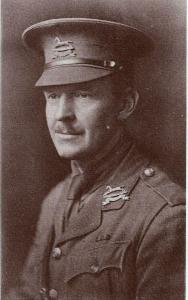
|

|
| Captain Percival Knight ALLEN | |
|
10th (Service) Battalion (Prince of Wales’ Own) West Yorkshire Regiment Date of birth: 17th October 1875 Date of death: 23rd April 1917 Killed in action aged 41 Buried at Feuchy Chapel British Cemetery, Wancourt Plot V Row E Grave 3 |

|
| Percival Knight Allen was born at 10 Elgin Road, Kensington on the 17th of October 1875 the third son of Theophilus Allen, an architect, and Elizabeth Mary (nee Cobbett) Allen later of "Stanyards", Chobham in Surrey. He was christened at the Church of St John the Evangelist, Notting Hill on the 3rd of December 1875. He was educated at Lancing College where he was in School House from May 1887 to July 1893. While he was there he won his Sports Colours in 1893 and was a member of the Football XI in 1892 and 1893. On leaving school he studied chemistry at the Pharmaceutical College in Bloomsbury. He then studied mine engineering and went to British Columbia in 1898 where he lived at Rossland. Following the outbreak of the South African War he enlisted at Nelson in British Columbia as Trooper 318 in Lord Strathcona’s Horse (Royal Canadians) on the 8th of February 1900. At a medical examination, which was held on the same day, it was recorded that he was five feet eight and half inches tall, that he weighed 158lbs and that he had a fair complexion, light hair and blue grey eyes. He saw action at Belfast and in the Orange Free State and was awarded the Queen’s Medal with three clasps. He was discharged from service at Ottawa on the 16th of March 1901 although he was on leave in England at the time. After the war he returned to South Africa where he worked as a sampler at mines near Johannesburg and later as a surveyor at Abosso Mine in West Africa. While in South Africa he served for seven years with the Witwatersrand Rifles as a 1st Sergeant and later as a 1st Lieutenant at their headquarters. In recognition of their service during the South African War, the Canadian Government passed the Volunteer Bounty Act of 1908 which offered each veteran 320 acres of Dominion land or $160 in lieu. Percival Allen applied for his grant on the 4th of October 1909. He was married to Violet Irene (nee Philpots) at Christ Church, Ottershaw in Surrey on the 30th of September 1916. On the outbreak of war he enlisted in London as Private 895 in the 10th (Service) Battalion Royal Fusiliers (Stockbrokers) on the 29th of August 1914. At a medical examination, which was held on the same day, it was recorded that he was five feet seven and three quarter inches tall with a fresh complexion, hazel eyes and light brown hair. He was posted for training to Reidshall Camp at Colchester where he joined 14 Platoon, D Company. On the 6th of October 1914 he applied for a commission and was commissioned as a Temporary Lieutenant in the 10th Battalion West Yorkshire Regiment on the 24th of October 1914. He embarked for France with his battalion on the 13th of July 1915, landing at Boulogne the at 11pm the same day. On the 13th of November 1916 he was admitted to 6 Red Cross Hospital at Etaples suffering from slight myalgia but returned to duty on the 5th of December. At midnight on the night of the 22nd/23rd of April 1917 the 10th Battalion West Yorkshire Regiment marched from the museum cellars in Arras, where they had been resting, to a line below the reverse crest of Orange Hill in preparation for an attack the following day on the German held position of Bayonet Trench which ran to the north of Monchy. This was part of a wider attack by the British on a nine mile front from Croisilles to Gavrelle which became known as the Second Battle of the Scarpe. At 4.45am the following morning the attack began with Bayonet Trench being allocated to the battalions of 51st Brigade, although 100 men of the battalion assisted in the assault under heavy shell fire. This attack failed and at 2.30pm the West Yorks received orders to continue the attack at 6pm with the objective of Rifle Trench while the 6th Battalion Dorset Regiment was detailed to resume the attack on Bayonet Trench. When the two battalions were spotted by the enemy advancing down the slope towards them, they opened a "hurricane" barrage of 5.9 and 8 inch shells with machine guns sited on the northern bank of the Scarpe joining in and sweeping their fire down the ranks of Yorkshiremen. Despite the murderous fire the West Yorks managed an advance of 200 yards before being forced to stop and dig in to the east of Lone Copse where they hung on until relieved by the 7th Battalion East Yorkshire Regiment. The survivors then withdrew to the old British front line where they supplied carrying parties for the East Yorks. Percival Allen was one of the many casualties they sustained that day. His wife received the following telegram dated the 29th of April 1917:- "Deeply regret to inform you Capt. P.K. Allen 10/West Yorkshire Regiment was killed in action April twenty third. The Army Council express their sympathy." His Colonel wrote:- "There is not an officer or man in the battalion who does not bitterly regret his loss. His splendid courage and great personal charm has earned the affection and respect of all ranks." He was described in letters from other officers as having a "total absence of fear". His brother, Lieutenant Humphrey Decius Allen, was killed in action with the same battalion on the 1st of July 1916. His widow applied for his medals in March 1922 giving her address as 8 Shaftesbury Road, Hammersmith London W6. |
|
| School House |
Back